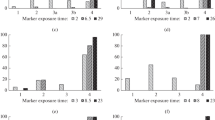Abstract.
In Nautilus pompilius, tracer experiments with 14C-labelled food show that the midgut gland, caecum and crop are involved in absorption of nutrients. According to liquid scintillation and light- and electron-microscopic autoradiography, the midgut gland exhibits the highest activity, followed by the caecum and crop. The density of silver precipitates is highest in the terminal alveoli of the midgut gland. Precipitates are also seen in the main cells of the caecal epithelium. Few precipitates are found in the lamina epithelialis mucosae of the crop, indicating that, in addition to food storage, digestive processes begin in this organ. These results have been confirmed by injection of the protein ferritin into the buccal cavity. The largest amount of ferritin is seen in the dense bodies of the main cells of the midgut gland, whereas those of the main cells of the caecum and crop contain less ferritin.
Similar content being viewed by others
Author information
Authors and Affiliations
Additional information
Electronic Publication
Rights and permissions
About this article
Cite this article
Westermann, B., Beuerlein, K., Ruth, P. et al. Tracer studies of food absorption in the digestive tract of Nautilus pompilius (Cephalopoda, Tetrabranchiata). Cell Tissue Res 300, 173–179 (2000). https://doi.org/10.1007/s004419900164
Received:
Accepted:
Issue Date:
DOI: https://doi.org/10.1007/s004419900164




